- Chapter 1 Some Aspects Of The French Revolution Multiple Choice Question And Answers
- Chapter 2 Revolutionary Ideals, Napoleonic Empire And Nationalism Multiple Choice Question And Answers
- Chapter 3 Europe In The 19th Century Multiple Choice Question And Answers
- Chapter 4 Industrial Revolution, Colonialism And Imperialism Multiple Choice Question And Answers
- Chapter 5 Europe In The Twentieth Century Multiple Choice Questions
- Chapter 6 The Second World War And Its Aftermath Multiple Choice Questions
- Chapter 7 The League Of Nations And The United Nations Organisation Multiple Choice Questions
Class 9 History
WBBSE Class 9 History Very Short Answer Questions
- Chapter 1 Some Aspects Of The French Revolution Very Short Answer Questions
- Chapter 2 Revolutionary Ideals, Napoleonic Empire And Nationalism Very Short Question and Answers
- Chapter 3 Europe In The 19th Century Very Short Answer Questions
- Chapter 4 Industrial Revolution, Colonialism And Imperialism Very Short Answer Questions
- Chapter 5 Europe In The Twentieth Century Very Short Answer Questions
- Chapter 6 The Second World War And Its Aftermath Very Short Answer Questions
- Chapter 7 The League Of Nations And The United Nations Organisation Very Short Answer Questions
WBBSE Class 9 History Short Answer Questions
- Chapter 1 Some Aspects Of The French Revolution Very Short Answer Questions
- Chapter 2 Revolutionary Ideals, Napoleonic Empire And Nationalism Short Answer Questions
- Chapter 3 Europe In The 19th Century Short Answer Questions
- Chapter 4 Industrial Revolution, Colonialism And Imperialism Short Answer Questions
- Chapter 5 Europe In The Twentieth Century Short Answer Questions
- Chapter 6 The Second World War And Its Aftermath Short Answer Questions
- Chapter 7 The League Of Nations And The United Nations Organisation Short Answer Questions
WBBSE Class 9 History Long Answer Questions
- Chapter 1 Some Aspects Of The French Revolution Long Answer Questions
- Chapter 2 Revolutionary Ideals, Napoleonic Empire And Nationalism Long Answer Questions
- Chapter 3 Europe In The 19th Century Long Answer Questions
- Chapter 4 Industrial Revolution, Colonialism And Imperialism Long Answer Questions
- Chapter 5 Europe In The Twentieth Century Long Answer Questions
- Chapter 6 The Second World War And Its Aftermath Long Answer Questions
WBBSE Solutions For Class 9 History Chapter 7 The League Of Nations And The United Nations Organisation Multiple Choice Questions
Class 9 History Chapter 7 WBBSE The League Of Nations And The United Nations Organisation Topic A Foundation and Organisation of the League of Nation Multiple Choice Questions
Question 1. The League of Nations was formed after-
1. First World War
2. Second World War
3. First Balkan War
4. Second Balkan War
Answer: 1. First World War
Question 2. President Wilson belonged to-
1. France
2. USA
3. Italy
4. Spain
Answer: 2. USA
Question 3. Which of the following personalities was most active in the establishment of the League of Nations?
1. Woodrow Wilson
2. Clemenceau
3. Lloyd George
4. Orlando
Answer: 1. Woodrow Wilson
Question 4. The country which did not join the League of Nations was-
1. Germany
2. Britain
3. America
4. Spain
Answer: 3. America
Read and Learn More WBBSE Class 9 History Multiple Choice Questions
Question 5. The session of the League of Nations was held in a year-
1. Once
2. Twice
3. Thrice
4. Weekly
Answer: 1. Once
Class 9 History Chapter 5 WBBSE
Question 6. The executive body of the League of Nations was called-
1. Security Council
2. Secretariat
3. Executive Board
4. Board of Directors
Answer: 1. Security Council
Question 7. The highest officer of the Secretariat of the League of Nations was called-
1. Secretary General
2. Chairman
3. General Secretary
4. Collector
Answer: 1. Secretary General
Question 8. Russia joined the League of Nations in
1. 1933
2. 1934
3. 1936
4. 1938
Answer: 2. 1934
Question 9. Japan gave up the membership of League of Nations in
1. 1933
2. 1938
3. 1992
4. 1900
Answer: 1. 1933
Question 10. Which treaty set up the League of Nations?
1. Treaty of Sevres
2. Treaty of Versailles
3. Treaty of St. Germain
4. Treaty of Trianon
Answer: 2. Treaty of Versailles
Class 9 History West Bengal Board
Question 11. The prestige of the League of Nations was generally satisfactory till –
1. 1920
2. 1930
3. 1940
4. 1950
Answer: 2. 1930
Question 12. In the beginning, the country which was not allowed membership was-
1. France
2. Britain
3. Britain
4. Canada
Answer: 2. Britain
Question 13. Which nation was a member of the League of Nations during its entire existence?
1. Japan
2. France
3. Germany
4. Russia
Answer: 2. France
Question 14. Which of the following is not associated with the organisation of the League?
1. A secretariat
2. A world bank
3. A court of international justice
4. An assembly
Answer: 2. A world bank
Chapter 7 The League Of Nations And The United Nations Organisation Topic B United Nations: Charter and Organisation Multiple Choice Questions (MCQ)
Question 1. The UNO was founded on-
1. 24 October 1945
2. 29 October 1946
3. 24 October 1947
4. 25 October 1946
Answer: 1. 24 October 1945
Question 2. The number of judges in the International Court of Justice is-
1. 15
2. 16
3. 17
4. 18
Answer: 1. 15
Class 9 History West Bengal Board
Question 3. The UN Charter was finalised and became effective-
1. San Francisco, 24 October, 1945
2. Paris, 5 March 1944
3. Yalta, 2 February 1945
4. None of these.
Answer: 1. San Francisco, 24 October 1945
Question 4. Trygve Lie, the first Secretary General of UNO, was from-
1. USA
2. Norway
3. Korea
4. France
Answer: 2. Norway
Question 5. The term of office of a judge of the International Court of Justice is-
1. 6 years
2. 8 years
3. 7 years
4. 9 years
Answer: 4. 9 years
Question 6. The number of principal organs of the United Nations is-
1. 6
2. 5
3. 4
4. 3
Answer: 1. 6
Question 7. The following is not associated with the UN-
1. ILO
2. WHO
3. ASEAN (Association for South East Asian Nations)
4. IMF
Answer: 3. ASEAN (Association for South East Asian Nations)
Question 8. Which of the following is not a chief organ of the UNO?
1. International Labour Organisation
2. Security Council
3. International Court of Justice
4. General Assembly
Answer: 1. International Labour Organisation
Question 9. The full form of ILO is-
1. Internal Labour Organisation
2. International Labour Organisation
3. International Lawyers’ Organisation
4. Internal Labour Office
Answer: 2. International Labour Organisation
Question 10. UNO was established after-
1. Russo-Japanese war
2. First World War
3. Second World War
4. The Battle of Waterloo
Answer: 3. Second World War
Question 11. Atlantic Charter was declared by-
1. Roosevelt and Churchill
2. Churchill and Stalin
3. Jawaharlal Nehru and Stalin
4. None of the above
Answer: 1. Roosevelt and Churchill
Question 12. The UN Charter was ratified in 1945 by-
1. 25 nations
2. 33 nations
3. 51 nations
4. 37 nations
Answer: 3. 51 nations
WBBSE Solutions For Class 9 History Chapter 7 The League Of Nations And The United Nations Organisation Very Short Answer Questions
Class 9 History WBBSE Chapter 7 The League Of Nations And The United Nations Organisation Topic A Foundation and Organisation of the League of Nation Very Short Answer (VSA) Type Questions
Question 1. What were the three principal organs of the League of Nations?
Answer:
The three principal organs of the League of Nations were:
[1] The Assembly.
[2] The Council and
[3] The Secretariat.
Question 2. Who could become members of the General Assembly of the League of Nations?
Answer: All the states which were members of the League of Nations were essentially members of the General Assembly.
Question 3. How were new members admitted in the League Assembly?
Answer: Any member could be admitted in the League Assembly by a vote of assent by of the existing members.
Question 4. Name the two great powers which were not members of the League in the beginning.
Answer: The two great powers which were not members of the League, in the beginning, were USA and Germany.
Read and Learn More WBBSE Class 9 History Very Short Answer Questions
Question 5. Who elected the temporary members of the League Council?
Answer: The temporary members of the League Council were elected by the League Assembly.
Question 6. Name the countries which first elected as members of the League Council.
Answer: The countries which were first elected as members of the League Council were England, France, Italy and Japan.
Class 9 History WBBSE
Question 7. What were the two autonomous bodies of the League of Nations?
Answer:
The two autonomous bodies of the League of Nations were:
[1] The Permanent Court of International Justice and
[2] The International Labour Organisation.
Question 8. When was the first session of the League convened?
Answer: The first session of the League was convened in 1920.
Question 9. Where was the first session of the League of Nations held?
Answer: The first session of the League of Nations was held in the city of Geneva, Switzerland.
Question 10. When was the last session of the League of Nations held?
Answer: The last session of the League of Nations was held on 14th December 1939.
Question 11. What is Covenant?
Answer: The Constitution of the League of Nations is called Covenant.
Question 12. How was the Secretary General of the League of Nations appointed?
Answer: The Secretary General of the League of Nations was appointed by the Council through the formal approval of the Assembly was necessary.
Question 13. When was the Permanent Court of International Justice opened and where?
Answer: The Permanent Court of International Justice was opened in 1922 in Hague, the erstwhile capital of Holland.
Question 14. What was the function of the Permanent Court of International Justice?
Answer: The function of the Permanent Court of International Justice was to settle international disputes which might be referred to it by the Council of the League and interpret international treaties and other legal complications.
Question 15. In which year the Aland Islands issue was settled by the League of Nations?
Answer: In 1921 the Aland Islands issue was settled by the League of Nations.
Class 9 History WBBSE
Question 16. Which commission was appointed by the League of Nations to determine the cause of the Japanese invasion of Manchuria?
Answer: The Lytton Commission was appointed by the League of Nations to determine the cause of the Japanese invasion of Manchuria.
History Class 9 WBBSE Chapter 7 The League Of Nations And The United Nations Organisation Topic B United Nations: Charter and Organisation Very Short Answer (VSA) Type Questions
Answer in one sentence
Question 1. Who selected the name United Nations Organisation?
Answer: The name United Nations Organisation was selected by the American President Franklin Roosevelt.
Question 2. From where did Franklin Roosevelt select the name United Nations Organisation?
Answer: Franklin Roosevelt selected the name United Nations Organisation from Lord Byron’s poem ‘The Childe Harold’s Pilgrimage’.
Question 3. When was the UNO established and where?
Answer: The UNO was first established on 24 October 1945, in New York, USA.
Question 4. For how many years and by whom are the members of the Security Council elected?
Answer: The members of the Security Council are elected for two years by the members of the General Assembly.
Question 5. How are new members admitted in the UNO?
Answer: New members are admitted in the UNO on the recommendation of the Security Council and by a vote of assent by 2/3 of the existing members of the General Assembly.
Question 6. How many members are there in the Security Council of the UNO at present?
Answer: There are 15 members in the Security Council of the UNO at present.
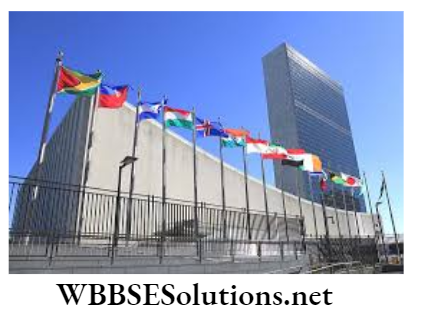
Question 7. What is the seventh principle enumerated in the UN Charter?
Answer: The seventh principle enumerated in the UN Charter is that the UN would not interfere in matters strictly within the domestic jurisdiction of any state.
Question 8. How many principles have been mentioned in the UN Charter?
Answer: Seven principles have been mentioned in the UN Charter.
Question 9. How many charter members were there in the UNO?
Answer: There were 51 charter members in the UNO.
History Class 9 WBBSE
Question 10. Which countries are the five members of the Security Council with the power of Veto?
Answer: The five members of the Security Council who have the power of Veto are the USA, USSR, England, France and China.
Question 11. What is the judicial organ of the United Nations?
Answer: The judicial organ of the United Nations is the International Court of Justice.
Question 12. How many judges are there in the International Court of Justice?
Answer: There are 15 judges in the International Court of Justice.
Question 13. How are the judges of the International Court of Justice elected?
Answer: The judges of the International Court of Justice are elected by the General Assembly and the Security Council.
Question 14. Name two organisations under the Economic and Social Council.
Answer: The two organisations under the Economic and Social Council are UNESCO (United Nations Educational Scientific and Cultural Organisation) and FAO (Food and Agricultural Organisation).
Question 15. What does UNICEF stand for?
Answer: UNICEF stands for United Nations International Children’s Emergency Fund.
Question 16. Where is the headquarters of WHO?
Answer: The headquarters of WHO is in Geneva.
Question 17. What does WHO stand for?
Answer: WHO stands for World Health Organisation.
Question 18. What does UNESCO stand for?
Answer: UNESCO stands for United Nations Educational, Scientific and Cultural Organisation.
History Class 9 WBBSE
Question 19. What is the composition of the Trusteeship Council?
Answer: The Trusteeship Council is composed of the representatives of permanent members of the Security Council, representatives of all those states which hold the administration of colonies and some representatives elected by the General Assembly.
Question 20. How is the head of the Secretariat of UNO appointed?
Answer: The head of the Secretariat, the Secretary-General, is appointed by the General Assembly on the recommendation of the Security Council.
Question 21. Who is the present secretary general of UNO?
Answer: The present secretary general of UNO is Antonio Guterres.
Question 22. When and where was the United Nations Declaration signed?
Answer: On 1 January 1942 the United Nations Declaration was signed in Washington.
Question 23. Where is the headquarter of Food and Agriculture Organisation (FAO)?
Answer: The headquarter of the Food and Agriculture Organisation is located in Rome.
WBBSE Solutions For Class 9 History Chapter 7 The League Of Nations And The United Nations Organisation Short Answer Questions
Class 9 History Book West Bengal Board WBBSE Chapter 7 The League Of Nations And The United Nations Organisation Topic A Foundation and Organisation of the League of Nation Short Answer Questions
Question 1. How was the League of Nations founded?
Answer:
League Of Nations Founded:-
The terrible repercussion of the First World War (1914-18) made a strong impact on the minds of the people and made them cry out for peace. President Woodrow Wilson of the United States of America took the initiative and made a plan to establish a world peace organisation known as the League of Nations which would solve disputes peacefully. The League of Nations was thus not only an expression of the call to peace, but it was also a means of promoting the call to peace.
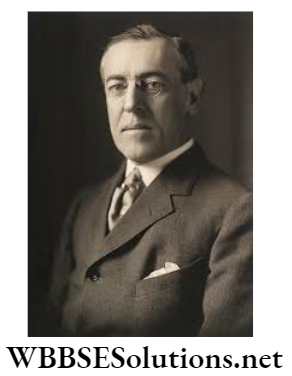
Question 2. With what aim was the League of Nations founded?
Answer:
Aim Of The League Of Nations Founded:-
After the First World War (1914-18) an international peace organisation known as the League of Nations was established in 1920 with the following aims in view:
[1] To prevent armed conflict and to promote international peace and cooperation,
[2] To establish honourable relations among different nations,
[3] To promote international disarmament in order to reduce tension and
[4] To find out ways and means for peaceful settlement of international disputes.
Read and Learn More WBBSE Class 9 History Short Answer Questions
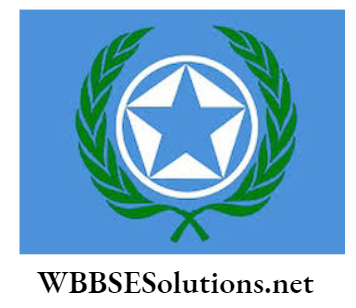
Question 3. Describe the structure of the League of Nations.
Answer:
Class 9 History WBBSE Structure Of The League Of Nations:-
The League of Nations had four main. organs, the first of which was the Assembly consisting of representatives of every member state, meeting once a year at Geneva.
The second organ was the Council i.e, the executive committee composed of one representative from each of the five permanent states (Great Britain, France, Germany, Italy and Japan) and temporarily of nine other member states, chosen by the Assembly.
The third was the permanent Secretariat, located at Geneva the main function of which was to prepare reports for the consideration of the Assembly and the Council. The fourth organ was the Permanent Court of International Justice which was a court of arbitration for the settlement of international disputes with its office at Hague.
Class 9 History Solutions WBBSE
Question 4. Write a note on the Covenant of the As United States did not accept the League of Nations.
Answer: The Constitution of the League of Nations called the Covenant consisted of 26 articles among which the tenth, twelfth and sixteenth articles were of great significance.
[1] Under the tenth article of the Covenant, the members of the League of Nations promised to respect the political independence and territorial integrity of the member countries of the League.
[2] According to the twelfth article, the members unanimously decided to solve their problems, through mutual negotiations.
[3] The sixteenth article made it clear that if any member country of the League of Nations declared war and violated settlements, that country would be declared the enemy of all nations and her aggression would be faced with all might.
Question 5. Give an account of the General Assembly of the new permanent members. The function of the League of Nations.
Answer: The League of Nations functioned through a number of organs, the most important of which was the Assembly. All the states which were members of the League were essentially members of the Assembly. Every member state could send three representatives, although no state had more than one vote.
The function of the Assembly of the League was:
[1] To establish world peace.
[2] To resolve international disputes.
[3] To extend international security and
[4] To work for safeguarding the interests of minorities.
Class 9 History Solutions WBBSE
Question 6. Who were the members of the League Council?
Answer:
The members of the League Council were divided into two divisions:
[1] Permanent members and
[2] Temporary members.
There were five permanent members of the Council, viz, Great Britain, USA, France, Italy and Japan. As the United States did not accept membership of the League of Nations, the number of permanent members remained at only four.
The number of temporary members were four. Later on, the number of permanent members were increased to six and temporary members to nine. Germany and Russia became the new permanent members.
Question 7. Give an account of the Council of the League of Nations.
Answer:
Council Of The League Of Nations:-
The League Council comprised nine four temporary members. The five permanent members of which five were permanent and members were Great Britain, the USA, France, Italy membership of the League, the number of and Japan. As the USA did not accept the on number of permanent members were permanent members remained only four. Later increased to six. Germany and Russia became the new permanent members.
The function of the League Council were:
[1] To discuss about various international disputes and to resolve them.
[2] To make efforts to stop a war and to reduce armament.
[3] Summoning of international conferences to resolve disputes.
Class 9 History Solutions WBBSE
Question 8. Who are the permanent members of the League Council?
Answer:
Permanent Members Of The League Council:-
The Council of the League consisted of four permanent members. Later the number of members were increased to six. England, France, Italy and Japan were permanent members. Later on, Russia and Germany were admitted as permanent members.
Question 9. What were the main functions of the League Council?
Answer:
The main functions, of the League Council, were:
[1] To discuss about various international disputes and to resolve them.
[2] To make efforts to stop war and to reduce armaments.
[3] Summoning of international conferences to resolve disputes.
Question 10. What was the function of the Secretariat and their obligations to the League. of the League of Nations?
Answer:
The function of the Secretariat of the League of Nations were:
[1] To list the subjects to be considered in the Assembly.
[2] To preserve the documents and necessary papers regarding the minutes of the meetings, settlements and treaties concluded among the member states,
[3] To offer necessary suggestions for effecting modifications in the treaties.
Class 9 History WBBSE
Question 11. Mention any two causes of the failure of the League of Nations.
Answer:
Two causes for the failure of the League of Nations were:
[1] the League was never able to make itself truly ‘representative of the entire world. Countries like USA, Germany, Russia, Italy and Japan were not members of the League at different stages and no international organisation can be really successful if some of the great powers remain outside of it.
[2] The League had no army, navy or air force of its own nor was it in a position to apply economic sanction on the Great Powers which looked after their own interests instead of fulfilling
Question 12. Who is known as the ‘Father of the League of Nations? Who was the first secretary-general of the league?
Answer:
1. US President Woodrow Wilson is known as the ‘Father of the League of Nations’.
2. The first secretary general of the League of Nations was Eric Drummond.
Question 13. Mention two features of the League of Nations.
Answer:
Two features of the League of Nations were:
[1] To settle international disputes by peaceful means.
[2] To settle all international legal disputes among the members of the league.
Class 9 History WBBSE Chapter 7 The League Of Nations And The United Nations Organisation Topic B United Nations: Charter and Organisation Short Answer (SA) Type Questions Answer
Question 1. How did the United Nations Organisation come into being?
Answer:
United Nations Organisation:-
The League of Nations collapsed under the impact of the Second World War and the allied powers felt the need of a world peace organisation. Winston Churchill, Prime Minister of Britain and Franklin Roosevelt, President of the USA announced the Atlantic Charter where the term ‘United Nations’ was first adopted.
In the Moscow Conference (1943) Britain, the USA, Russia and China were unanimous that an international peace organisation should be set up. This resolution was confirmed in the Dumberton Oaks Conference (1944) and Yalta Conference (1945). Representatives of 50 nations met at San Francisco (1945) and prepared a Charter for world peace called UN Charter. On 24 October 1945, the United Nations Organisation (UNO) came into existence.
Question 2. What are the principal aims (objectives) of the UNO?
Answer:
The principal aims (objectives) of the UNO established after the Second World War are:
[1] to maintain world peace, prevent armed conflict among nations, promote the peaceful settlement of international disputes and to remove international tension.
[2] to promote education, culture and health of mankind and to promote the economic condition of the poor and underdeveloped nations.
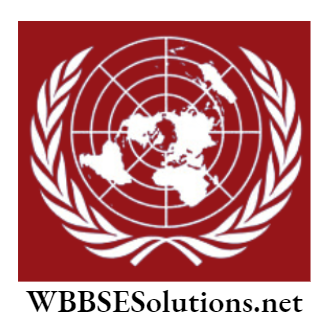
Question 3. What is the UN Charter?
Answer:
UN Charter:-
Between April and June 1945 representatives of 50 nations who were directly or indirectly involved in the war against the Axis Powers (Germany, Italy and Japan) met at a conference at San Francisco. The Big Four (Britain, France, USA, and Russia) dominated the conference and prepared a charter for world peace called the UN Charter.
Class 9 History WBBSE
Question 4. What are the basic principles of UNO?
Answer:
The basic principles of UNO are:
[1] All the members, big or small, in order to enjoy the rights and benefits would sincerely carry out their duties as per the UNO charter.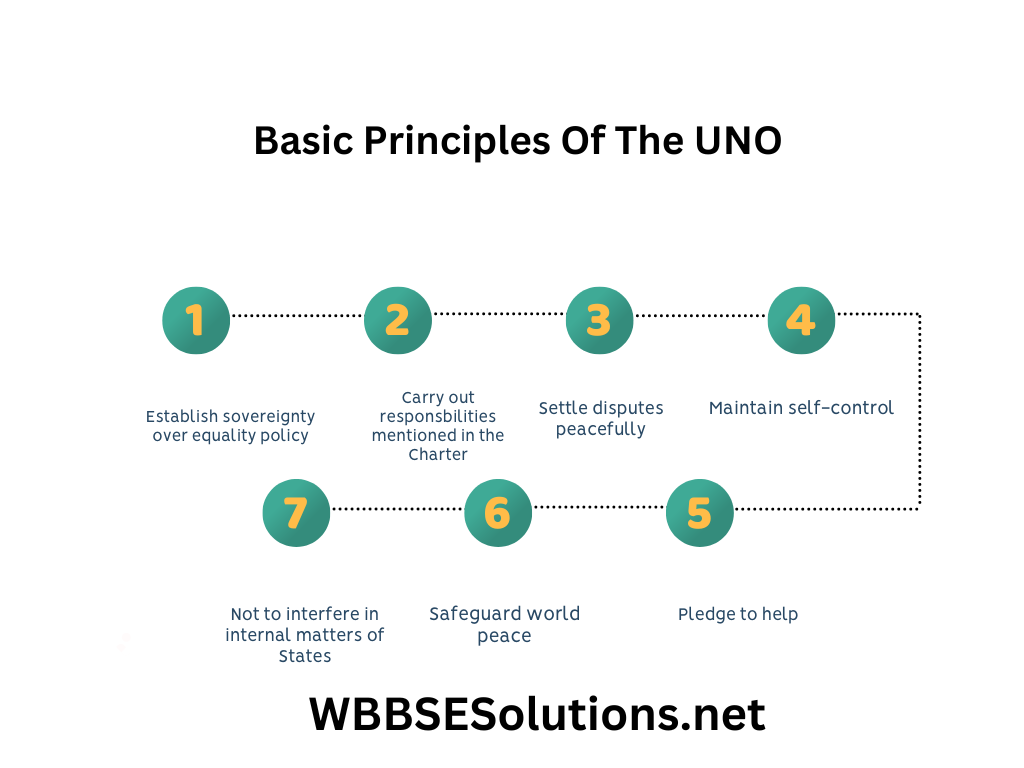
[2] All the members shall settle international disputes by peaceful means.
[3] UNO would not interfere in the internal affairs of any country.
[4] All members would enjoy the same sovereign status.
[5] All members pledge to help.
[6] All members would safeguard world peace.
Question 5. Write a note on membership of the UNO.
Answer:
Membership Of The UNO:-
[1] The membership of the UNO is open to all peace-loving nations of the world which accept the obligation of the UNO and are willing to carry out these obligations.
[2] 51 states who signed the UN Charter are the original members of the UN.
[3] Any member could be admitted in the UN on the recommendation of the Security Council and by a vote of assent by of the existing members of the General Assembly.
[4] America, England, France, Russia and China are the permanent members of the UN Security Council.
[5] If member countries persistently violate the principles of the Charter they may be expelled by the General Assembly on the recommendation of the Security Council.
Question 6. What is the function of the International Court of Justice?
Answer:
Function Of The International Court Of Justice:-
The function of the International Court of Justice is to solve the legal disputes that arise between different countries e.g. interpretation of treaties, application of principles of international law to a particular dispute or situation and settles issues of commensurate compensation for breach of international law etc. It also gives legal advice to the Security Council and the General Assembly.
Class 9 History WBBSE
Question 7. What is FAO and WHO?
Answer:
FAO And WHO:-
FAO and WHO are two specialised agencies of the Economic and Social Council. FAO is Food and Agricultural Organisation and WHO is World Health Organisation.
Question 8. What are the six main organs of the UNO?
Answer:
The six main organs of the United Nations organisation are:
[1] The General Assembly.
[2] The Security Council.
[3] The Economic and Social Council.
[4] The Trusteeship Council.
[5] The International Court of Justice and
[6] The Secretariat.
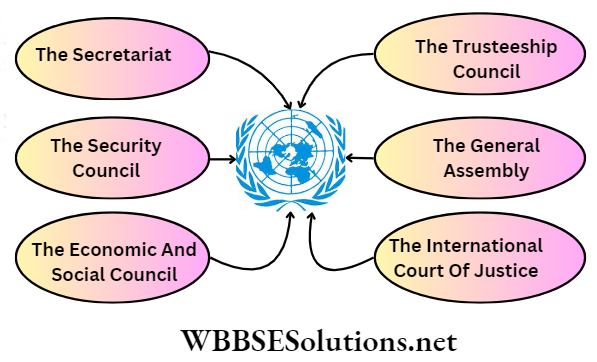
Question 9. Why is 24 October celebrated as United Nations Day?
Answer:
24 October Celebrated As United Nations Day:-
Between April and June of 1945, representatives of 50 nations who were directly or indirectly involved in the war against the Axis Powers met at a conference led by Britain, France, the USA and Russia at San Francisco and prepared a charter for world peace called the UN Charter. The Charter became officially effective on 24 October. So this day is celebrated as the United Nations Day.
Question 10. What is ‘Veto’?
Answer:
Veto:-
The foremost responsibility of the Security Council is the maintenance of international peace and security. All the five permanent members of the Security Council (USA, USSR, UK, France and China) must agree on all important issues. A negative vote by any one permanent member is called a ‘Veto’. If the Veto is exercised, then the proposal or resolution is considered not passed. So on this issue, the Security Council cannot take any action.
Class 9 History Solutions WBBSE
Question 11. What are the different specialised agencies of the Economic and Social Council?
Answer:
The different specialised agencies of the Economic and Social Council are:
[1] ILO (International Labour Organisation).
[2] UNESCO (United Nations Educational Scientific and Cultural Organisation).
[3] WHO (World Health Organisation).
[4] FAO (Food and Agricultural Organisation).
[5] IMF(International Monetary Fund)
Question 12. What is the composition of the General Assembly?
Answer:
Composition Of The General Assembly:-
The General Assembly of the UNO consists of all member states of the United Nations Organisation. Each member state can send five representatives to the session of the General Assembly. The total strength of the UN General Assembly is now 193.
Question 13. What is the composition of the Security education, and improvement of the standard of the Council of the United Nations Organisation? Or, Write a note on the membership of the Security Council.
Answer: The most important organ of the UNO is the Security Council. There are two types of members in Council-permanent and non-permanent. Five permanent members are the USA, USSR, UK, France and China. The ten non-permanent members are elected by the General Assembly for a term of two years.
Question 14. Name the permanent members of the Security Council of the UNO.
Answer:
The permanent members of the Security Council of the UNO are:
[1] America.
[2] England.
[3] France.
[4] Soviet Russia.
[5] China.
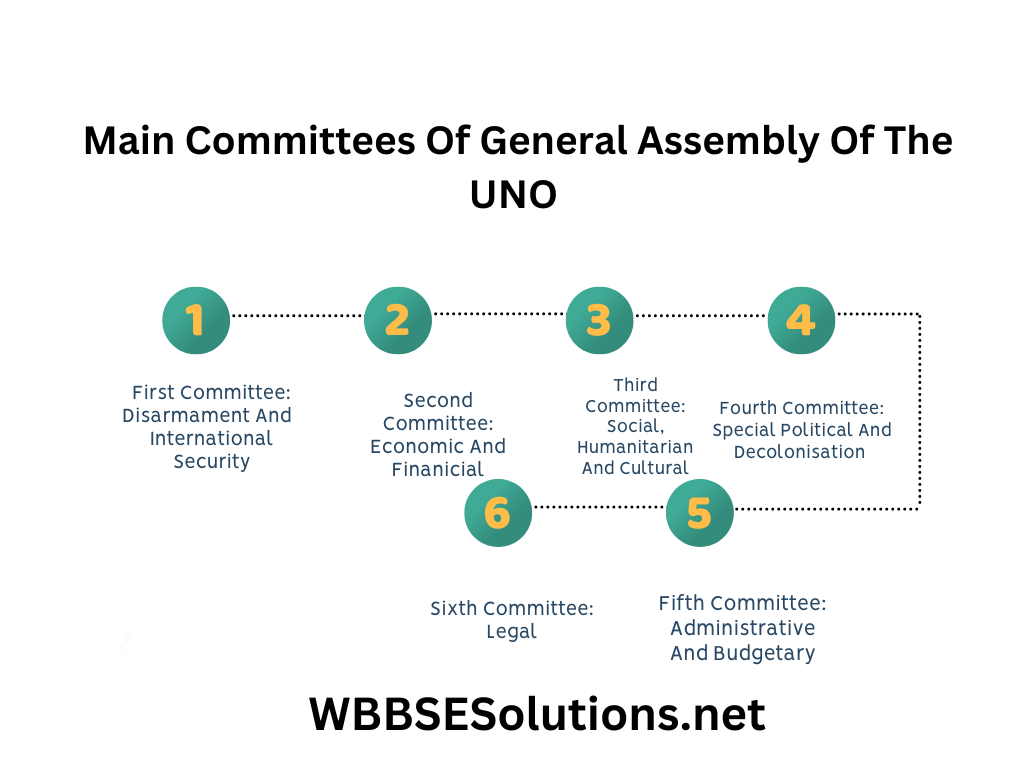
Question 15. What are the functions of UNESCO?
Answer:
Functions Of UNESCO:-
UNESCO deals with the issues of economic and social welfare and works for the preservation of human rights across the globe. This body fights against illiteracy and devotes itself to the protection of health, the spread of living of the people. The task before UNESCO includes education, social science, natural science, mass communication, cultural activities and relief services.
Question 16. What are the functions of WHO?
Answer:
Functions Of WHO:-
WHO (World Health Organisation) organises campaigns throughout the world against diseases such as pox, plague, smallpox, cholera and others. It undertakes medical research to find out the causes of diseases, improve vaccines and train medical research and aid workers.
Question 17. What are the functions of UNICEF?
Answer:
Functions Of UNICEF:-
The function of UNICEF is to help the establishment was to improve the condition of
member countries improve the health condition of their children and to save the lives of sick or starving children in the world who suffer from malnutrition, hunger and different kinds of diseases. It also looks after social welfare and vocational training of children. It also helps in the production of inexpensive books for children.
Question 18. What are the functions of the Security countries? An indirect function of the Trustee- Council of the UNO?
Answer:
The functions of the Security Council of the UNO are:
[1] To maintain international peace and security,
[2] To investigate all disputes and recommends ways and means for a peaceful settlement,
[3] To take action against a defaulting state and ask its members to send military forces in order to control a dangerous
situation.
Question 19. What are the functions of the Economic and Social Council?
Answer:
The functions of the Economic and Social Council (ECOSOC), a non-political organ of the UNO are:
[1] to promote the economic and social advancement of all people,
[2] planning of economic development, financial and technical assistance to underdeveloped countries, industrialisation of backward countries, improvement of education and aid to the world’s needy children,
[3] to appoint special committees from time to time to study specific problems.
Question 20. Write a short note on International Labour Organisation (ILO).
Answer:
International Labour Organisation (ILO):-
The headquarters of the International Labour Organisation was established at Geneva. All the member-states were also members of the International Labour Organisation. The main aim behind its establishment was to improve the condition of the labourers in different countries.
Question 21. Write a note on the function of the Trusteeship Council.
Answer:
Function Of The Trusteeship Council:-
After World War II, some underdeveloped countries were placed under the supervision of the Council. The primary task of the Council is to look after the economic, social, political and cultural development of these Countries. An Indirect function of the Trusteeship Council is to eliminate the possibility of rivalry among powerful nations of the world for the exploitation of underdeveloped nations.
Question 22. What is the function of the head of the Secretariat?
Answer:
Function Of The Head Of The Secretariat:-
The head of the Secretariat, the Secretary-General, prepares an annual progress report of the UNO and places it before the General Assembly. He has the right to draw the attention of the Security Council to any matter which in his opinion, may threaten international security.
Question 23. When was the Yalta Conference held? Name the countries which took part in the Yalta Conference.
Answer:
1. The Yalta Conference was held in 1945.
2. The countries which took part in the Yalta Conference were USA, Britain and Russia.
Question 24. When and where was the Atlantic Charter signed?
Answer:
Atlantic Charter:-
The Atlantic Charter was signed on 11 August 1941. Winston Churchill, the Prime Minister of Britain, and Franklin Roosevelt, President of the USA met together on a warship called the ‘Prince of Wales’ in the Atlantic Ocean near Newfoundland and signed the Atlantic Charter.
Question 25. What is the importance of the Atlantic Charter?
Answer:
Importance Of The Atlantic Charter:-
The Atlantic Charter is important because it contained the aims and fundamental principles for the reconstruction of the post-Second World War. An indication to set up a world organisation for the preservation of peace in the world was given in this Charter. In this Charter, the term ‘United Nations’ was first adopted.
Question 26. Mention two limitations of the UNO.
Answer:
Limitations Of The UNO:-
[1] The first limitation of the UNO is that the right of absolute veto has been given to each of the ‘Big Five (USA, UK, France, China and Russia). The Big Powers have always on several occasions misused this right in their self interest.
[2] UNO has not achieved success in gaining the cooperation of all the ‘Big Five’ at a time on the question of the enforcement of the decision of the Security Council with the help of an international army.
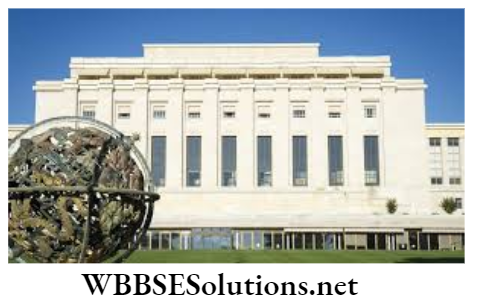
Question 27. Give an account of the success and failure of the League of Nations.
Answer:
Success And Failure Of The League Of Nations:-
The League of Nations utterly failed in its fundamental aim to prevent war and to maintain peace and order in the world on a permanent basis. The world had to witness again the Second World War in 1939 which proved the failure of the League.
On the other hand, if we evaluate the work of the League of Nations we find that the League tried its best to solve political disputes and the controversies which arose among different countries. In addition to this, the League acted also in the social and humanitarian fields for the benefit of mankind.
WBBSE Solutions For Class 9 History Chapter 6 The Second World War And Its Aftermath Multiple Choice Questions
Class 9 History West Bengal Board Chapter 6 The Second World War And Its Aftermath Topic A The Causes and Course of the Second World War Multiple Choice Questions (MCQ)
Question 1. The main cause of World War II was the-
1. Balkan War
2. World War I
3. Russo-German War
4. Anglo-French War
Answer: 2. World War I
Question 2. Chamberlain took assurance from Hitler that Germany would be satisfied by-
1. Occupation of Rhineland
2. Occupation of Poland
3. Cession to her of Sudetenland
4. Cession to her of Baltic states
Answer: 2. Occupation of Poland
Question 3. A secret additional pact to divide Poland was made between-
1. Russia and Germany
2. Germany and Italy
3. Italy and France
4. England and France
Answer: 1. Russia and Germany
Question 4. To plan global military strategy, top Allied leaders held a series of conferences such as the ones at-
1. Versailles
2. Tehran
3. Paris
4. Berlin
Answer: 2. Tehran
Read and Learn More WBBSE Class 9 History Multiple Choice Questions
Question 5. At the Munich Conference in 1938, a region of this nation was given to Adolf Hitler by the British and the French-
1. Czechoslovakia
2. Holland
3. Poland
4. Austria
Answer: 1. Czechoslovakia
Question 6. Which Allied army fought its way to Berlin and reached the city first?
1. England
2. Soviet Russia
3. France
4. USA
Answer: 2. Soviet Russia
Class 9 History West Bengal Board
Question 7. When did Hitler become Chancellor of Germany?
1. 1793
2. 1795
3. 1796
4. 1801
Answer: 2. 1795
Question 8. What was the last major attempt at a peaceful resolution with Germany prior to the outbreak of World War II?
1. Potsdam Conference
2. The Washington Conference
3. The Munich Conference
4. Yalta Conference
Answer: 3. The Munich Conference
Question 9. The main Axis Powers of World War II consisted of-
1. Germany, Finland, Japan
2. Germany, Italy, Japan
3. Germany, Russia, Italy
4. Germany, Italy, Belgium
Answer: 2. Germany, Italy, Japan
Question 10. The term ‘D-Day’ refers to-
1. Allied invasion of the coast of Normandy
2. Allied invasion of Italy
3. Allied invasion of Germany
4. Allied invasion of Poland
Answer: 1. Allied invasion of the coast of Normandy
Question 11. World War II broke out on-
1. 1 September 1938
2. 3 September 1939
3. 5 December 1933
4. 9 August 1937
Answer: 2. 3 September 1939
Question 12. What agreement did Hitler defy when the invasion of the USSR began?
1. Hitler-Stalin agreement
2. Molotov-Ribbentrop Pact
3. Comprehensive Nuclear Test Ban Treaty
4. Treaty of Versailles
Answer: 2. Molotov-Ribbentrop Pact
Class 9 History West Bengal Board
Question 13. What day was the invasion of Normandy or D-Day?
1. 6 June 1943
2. 12 May 1940
3. 6 June 1944
4. 3 September 1946
Answer: 3. 6 June 1944
Question 14. What caused the United States to enter the war on the side of the Allies?
1. Germany’s invasion of France
2. Germany’s invasion of Poland
3. Japan’s attack on Pearl Harbour
4. Russia’s entry into the war
Answer: 3. Japan’s attack on Pearl Harbour
History Class 9 Chapter 6 WBBSE The Second World War And Its Aftermath Topic B Impact of the Second World War and Ultranationalism vs Internationalism Multiple Choice Questions (MCQ)
Question 1. A great supporter of aggressive nationalism-
1. Churchill
2. Stalin
3. Hitler
4. Roosevelt
Answer: 3. Hitler
Question 2. The top allied leaders held a conference in-
1. Normandy
2. Venice
3. Tehran
4. Moscow
Answer: 3. Tehran
Question 3. European Recovery Programme was announced by-
1. Hitler
2. Goering
3. Mussolini
4. George Marshall
Answer: 4. George Marshall
Question 4. The United Nations Organisation was established-
1. To divide Germany into four zones
2. To establish international peace
3. To supervise the working of Germany
4. To preserve neutrality among the allies
Answer: 2. To establish international peace
WBBSE Solutions For Class 9 History Chapter 6 The Second World War And Its Aftermath Very Short Answer Questions
WBBSE Class 9 History Chapter 6 The Second World War And Its Aftermath Topic A The Causes and Course of the Second World War Very Short Answer (VSA) Type Questions
Answer in one sentence
Question 1. Which treaty is known as a ‘dictated peace’?
Answer: The Treaty of Versailles is known as a ‘dictated peace’.
Question 2. What is the name of the republic that was established after 1918 in Germany?
Answer: The name of Republic that was established after 1918 in Germany was known as the Weimer Republic.
Question 3. On which date did the Second World War begin?
Answer: The Second World War began on 1st September 1939.
Question 4. Who was the Prime Minister of England when the Second World War started?
Answer: Neville Chamberlain was the Prime Minister of England when the Second World War started.
Read and Learn More WBBSE Class 9 History Very Short Answer Questions
Question 5. Who was the Prime Minister of France when the Second World War broke out?
Answer: Daladier was the Prime Minister of France when the Second World War broke out.
Question 6. Who was the founder of the Nazi Party?
Answer: The founder of the Nazi Party was Hitler.
Question 7. When did Germany withdraw from the League of Nations?
Answer: Germany withdrew from the League of Nations in 1933.
Question 8. Which country was first attacked by Hitler during the Second World War?
Answer: Poland was first attacked by Hitler during the Second World War.
Question 9. Which port of Poland was demanded by Hitler?
Answer: Danzig, a port of Poland was demanded by Hitler.
WBBSE Class 9 History
Question 10. Who was Hindenburg?
Answer: Hindenburg was the President of the German Republic.
Question 11. Which country other than Germany and Italy was part of the Axis group of nations?
Answer: Japan was part of the Axis group of nations other than Germany and Italy.
Question 12. Which British Prime Minister appeased Germany?
Answer: The British Prime Minister who appeased Germany was Neville Chamberlain.
Question 13. When did Japan attack Manchuria?
Answer: Japan attacked Manchuria in 1931.
Question 14. Which British warships were drowned by German U-boats?
Answer: The British warships HMS Courageous and the HMS Royal Oak were drowned by German U-boats.
Question 15. Who was Mac Arthur?
Answer: Mac Arthur was the American military General.
Question 16. Which American naval base in the Pacific Ocean was attacked by Japan?
Answer: The American naval base at Pearl Harbour was attacked by Japan.
Question 17. In which year was Pearl Harbour attacked by Japan?
Answer: Pearl Harbour was attacked by Japan in 1941.
Question 18. In which year did Hitler attack Russia?
Answer: Hitler attacked Russia in 1941.
Question 19. In which year did Japan surrender to the Allies during the Second World War?
Answer: Japan surrendered to the Allies during the Second World War in 1945.
Question 20. When did the Second World War come to an end?
Answer: The Second World War came to an end in 1945.
WBBSE Class 9 History
Question 21. Where is Pearl Harbour located?
Answer: Pearl Harbour is located on the island of O’ahu in Hawaii.
Question 22. Who were the US Presidents during World War II?
Answer: Franklin Delano Roosevelt and Harry S Truman both served as United States Presidents during World War II.
Question 23. Name the World War II General who went on to become President of the United States of America.
Answer: The World War II General Eisenhower went on to become the President of the United States of America.
Question 24. In which year was the Tehran Conference held?
Answer: The Tehran Conference was held in 1944.
Question 25. In which year was the San Francisco Conference held?
Answer: The San Francisco Conference was held in 1945.
Question 26. Who is the author of the poem ‘The White Man’s Burden’?
Answer: The author of the poem ‘The White Man’s Burden’ is Rudyard Kipling.
Question 27. What is the concept of ‘The White Man’s Burden’?
Answer: ‘The White Man’s Burden’ is the idea that white people are superior to the non-white races and so, colonial rulers have a duty to take care of and ‘civilise’ the native inhabitants of their colonies.
Question 28. When and between whom was the Russo- German Non-Aggression Pact signed?
Answer: The Russo-German Non-Aggression Pact was signed on 23 August 1939 between Russian foreign minister Molotov and German foreign minister Ribbentrop.
Question 29. After which incident did the USA join the Second World War?
Answer: When Japan attacked the US naval base at Pearl Harbour, USA joined the World War II.
Question 30. What was the direct cause of the Second World War?
Answer: The direct cause of the Second World War was Hitler’s attack on Poland.
Question 31. Which day is known as the ‘D-Day’ (Deliverance Day)?
Answer: 6th June 1944 is known as the ‘D-Day’.
WBBSE Class 9 History
Question 32. Who followed the policy of appeasement?
Answer: The Prime Minister of Britain, Neville Chamberlain and Edouard Daladier, the Premier of France followed this policy.
Question 33. Name the countries which took part in the Second World War.
Answer: The countries which took part in the Second World War were Germany, Italy, Japan, Britain, France, Soviet Union, USA, Poland, Yugoslavia, Romania, Greece, Austria, Czechoslovakia, Hungary, Holland, Belgium, Finland, Bulgaria, Albania, Norway, Denmark etc.
Question 34. When did the Second World War come to an end?
Answer: The Second World War came to an end on 2 September 1945.
Question 35. For how many years did the Second World War continue?
Answer: The Second World War started on 1 September 1939 and ended on 2 September, 1945-so the war continued for 6 years.
Question 36. What was the aim of the Versailles Treaty?
Answer: The Treaty of Versailles aimed to weaken Germany both economically and militarily.
Question37. In which year was the Battle of Britain fought?
Answer: The Battle of Britain was fought in 1940.
Question 38. What was the main reason of the defeat of Germany in the Second World War?
Answer: The main reason of the defeat of Germany in the Second World War was the conspiracy of the German generals and the discontent of the soldiers.
Question 39. Name the Czar of Russia who established his capital at Leningrad.
Answer: The Czar of Russia who established his capital at Leningrad was Peter the Great.
Question 40. Who followed the ‘One by one policy’?
Answer: Hitler, the German dictator, followed the ‘One by one policy.
Question 41. Why was Hitler in favour of a union between Germany and Austria?
Answer: Hitler was in favour of the union between Germany and Austria as a sizeable number of Germans lived in Austria.
Question 42. Under whose leadership did the Russian
Answer: Under the leadership of Marshall Zhukov’s army defeat the Germans. the Russian army defeated the Germans.
History Class 9 WBBSE
Question 43. How did the USA become the arsenal of democracy?
Answer: USA became the arsenal of democracy when the American Senate enacted the Lend-Lease Act in March 1941 and allowed the US government to offer warships, warplanes and other weapons to the Allied powers to fight against Fascism.
Question 44. Which Act made USA the ‘Arsenal of Democracy’?
Answer: The Lend-Lease Act enacted by the American Senate in 1941 made USA the ‘Arsenal of Democracy’.
Question 45. Which day is regarded as ‘a date which will live in infamy in the USA?
Answer: The day which is regarded as ‘a date which will live in infamy in the history of USA is 7 December 1941 as Japan bombed the US naval base at Pearl Harbour on this day.
Question 46. When was ‘Victory-in-Europe Day’ observed?
Answer: Germany surrendered to the Allied Powers formally on May 7, 1945, and the whole of Europe observed May 8, 1945, as ‘the Victory-in-Europe Day’.
Question 47. What was the Grand Alliance?
Answer: USA, Great Britain and Soviet Russia formed an alliance against the Axis powers which is known as the Grand Alliance.
Question 48. What was the ‘Lend-Lease Act’?
Answer: The American Senate enacted the Lend-Lease Act in March 1941 and allowed the Us government to offer warships, warplanes and other weapons to the Allied powers to fight against fascism.
Question 49. Under whose leadership did the German soldiers start ‘Operation Barbarossa’?
Answer: The German soldiers started ‘Operation Barbarossa’ under the leadership of Hitler.
Question 50. When and by whom was the Anglo-Russian Alliance signed?
Answer: Churchill, the British Prime Minister, concluded the Anglo-Russian Alliance of 1941.
Question 51. Which incident made Far East the centre of war during World War II?
Answer: The Japanese attack on the US naval base at Pearl Harbour made the Far East the centre of war during the World War II.
Question 52. After which invasion did the ‘Beginning of the end’ of Germany start under the leadership of Hitler?
Answer: After the invasion of Russia, the ‘Beginning of the end’ of Germany started under the leadership of Hitler.
Question 53. Name the two atom bombs dropped by USA on Japan.
Answer: USA dropped the atom bombs named ‘Little boy on Hiroshima and ‘Fat man’ on Nagasaki in Japan.
History Class 9 WBBSE
Question 54. Why did Hitler attack Poland?
Answer: After the Munich Pact, Hitler demanded the use of the port of Danzig and also the Polish corridor to reach the port. When Poland refused this demand, Hitler attacked Poland.
Question 55. What was the aim of Hitler’s foreign policy?
Answer: Hitler’s foreign policy aimed at German expansion in East Europe in order to carve out some ‘Living Space’ (Lebensraum) for the surplus German population.
Class 9 History WBBSE Chapter 6 The Second World War And Its Aftermath Topic B Impact of the Second World War and Ultranationalism vs. Internationalism Very Short Answer (VSA) Type Questions
Answer in one sentence
Question 1. Who first popularised the term ‘Cold War’?
Answer: The term ‘Cold War’ was first popularised by Walter Lipmann.
Question 2. Name the two parties in the Cold War.
Answer:
The two parties in the Cold War were-
[1] United States of America and
[2] Soviet Russia.
Question 3. Which two superpowers were the main rivals in the Cold War?
Answer:
The two superpowers who were the main rivals in the Cold War were-
[1] United States of America and
[2] Soviet Russia.
Question 4. What does NATO stand for?
Answer: NATO stands for North Atlantic Treaty Organisation.
Class 9 History WBBSE
Question 5. What does SEATO stand for?
Answer: SEATO stands for South East Asia Treaty Organisation.
Question 6. In which year was Truman Doctrine proclaimed?
Answer: Truman Doctrine was proclaimed in 1947.
Question 7. In which year was Marshall Plan proclaimed?
Answer: Marshall Plan was proclaimed in 1947.
Question 8. What is meant by Third World countries?
Answer: A group of developing countries in Asia, Africa and South America which achieved independence after the Second World War were known as the Third World countries.
Question 9. When was the UNO established?
Answer: UNO was established on 24 October 1945.
Question 10. What is the Non-Alignment policy?
Answer: Non-Alignment policy which aims at ensuring international peace, means keeping away from the two military blocks led by USA and USSR and solving all international conflicts and disputes peacefully through cooperation.
Question 11. To which country did admiral Karl Donitz belong during the Second World War?
Answer: Karl Donitz was the admiral of Germany during the Second World War.
Question 12. Who wrote the poem ‘The White Man’s Burden’?
Answer: Rudyard Kipling wrote the poem ‘The White Man’s Burden’.
Question 13. In which essay did Rabindranath criticise radical nationalism?
Answer: Rabindranath in his essay ‘The Crisis in Civilisation’ criticised radical nationalism.
Question 14. What is V-2? Which country used the V-2 during the Second World War?
Answer:
1. V-2 was the rocket used during the Second World War.
2. V-2, the long-range rocket was used by Germany during the Second World War.
Question 15. Which country used the V-2 rocket and against whom?
Answer: During the Second World War Germany used a V-2 rocket against England.
Question 16. Who coined the term ‘Third World’?
Answer: Alfred Sauvy coined the term ‘Third World’.
Class 9 History WBBSE
Question 17. What was the name of the atomic bomb dropped on the Japanese city of Hiroshima?
Answer: The name of the atomic bomb dropped on the Japanese city of Hiroshima is ‘Little Boy’.
Question 18. Which day is celebrated as Hiroshima and Nagasaki Day?
Answer: August 9 is celebrated as Hiroshima and Nagasaki Day.
Question 19. Name the international organisation established after the Second World War.
Answer: The international organisation established after the Second World War was the United Nations Organisation (UNO).
WBBSE Solutions For Class 9 History Chapter 6 The Second World War And Its Aftermath Short Answer Questions
WBBSE Class 9 History Chapter 6 The Second World War And Its Aftermath Topic A The Causes and Course of the Second World War Short Answer (SA) Type Questions
Answer in 2 to 3 sentences
Question 1. Name the Allied and Axis powers in the Second World War.
Answer:
Allied And Axis Powers In The Second World War:-
In the Second World War, the Allied powers were England, France, USSR, USA and China. The Axis powers were Italy, Germany and Japan.
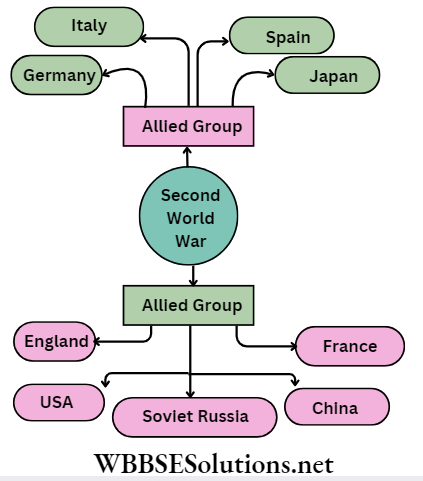
Question 2. Through which military campaign did Mussolini try to fulfil his imperial ambition?
Answer: The fascist government under Mussolini became hungry for colonies and Mussolini tried to fulfil his imperial ambitions through his military campaign in the East African country of Ethiopia (Abyssinia). In 1935 he attacked Ethiopia to exploit its minerals and raw materials for industrial development and Ethiopia was formally annexed in 1936.
Read and Learn More WBBSE Class 9 History Short Answer Questions
Question 3. Write a note on the bombing by USA at Hiroshima and Nagasaki.
Answer:
Bombing By USA At Hiroshima And Nagasaki:-
USA prepared a plan to drop a newly discovered atomic bomb on Japan on August 6, 1945. The atomic bomb was dropped on Hiroshima, an industrial town in Japan, which destroyed half the city and caused 80,000 deaths. This was the first use of the atom bomb during World War II.
WBBSE Class 9 History
On August 9, a second atomic bomb was dropped in Nagasaki in Kyum, destroying the whole municipal area and killing 40,000 people. The whole world was alarmed at the extensive destructive capacity of these
new weapons.
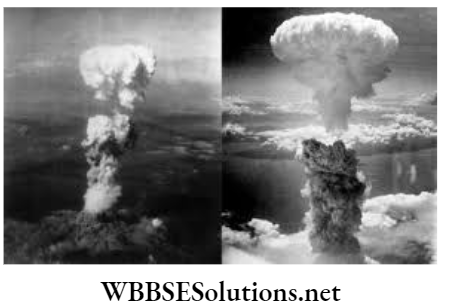
Question 4. Why did Hitler sign the Munich Pact?
Answer:
Hitler Sign The Munich Pact:-
England and France followed the policy of appeasement towards Hitler and signed the Munich Pact in 1938. Hitler agreed to sign the Munich Pact because-
[1] Germany was authorised to occupy four border provinces of Czechoslovakia within ten days.
WBBSE Class 9 History
[2] The Czechoslovakian government was forced to release all the political prisoners of Sudeten- land. This territory was also given to Germany.
Question 5. Which incident forced the USA to join the Second World War?
Ans. The sudden Japanese air attack with 360 aircraft struck at the American fleet at Pearl Harbour in the Hawaiian Islands on 7 December 1941″ and wiped out all the American planes on the ground there. This incident at Pearl Harbour forced USA to join the Second World War.
Question 6. Write a note on the Battle of Leningrad.
Answer.
Battle Of Leningrad:-
At the initial stage of the Second World War, the German army achieved great success. They besieged Leningrad. The Soviet army followed the ‘Scorched Earth’ policy and guerilla model of warfare. As a result, the Nazi forces began to retreat. In the beginning of 1942, Leningrad was vacated by the Russian Red Army.
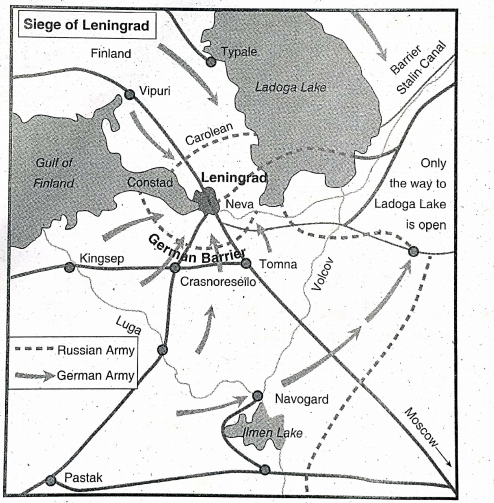
Question 7. Which book is known as the ‘Bible of the Nazi Party’? Who was its author?
Answer:
1. ‘Mein Kampf is known as the Bible of the Ans.! In 1933 Germany withdrew from the Nazi Party.
2. Its author was Hitler.
Question 8. Why did Germany withdraw from the League of Nations?
Answer: In 1933 Germany Withdrew from the League of Nations. According to the terms of the Treaty of Versailles Germany was disarmed. Germany’s demands for military parity with other European powers was refused by the western powers, so Germany withdrew herself from the League of Nations.
History Class 9 WBBSE
Question 9. What was Vichy government?
Answer:
Vichy Government:-
A puppet French government led by Petain was established under the control of Germany in France. As Vichy was the capital of this new French government it was also called the Vichy Government.
Question 10. When was the Yalta Conference held? Name the countries which took part in the Yalta Conference.
Answer:
1. The Yalta Conference was held in 1945.
2. The countries which took part in the Yalta Conference were USA, Britain and Russia.
Question 11. Name three prominent leaders who attended the Yalta Conference. Name any two military alliances which came into being as a consequence of Cold War.
Answer:
Three prominent leaders who attended the Yalta Conference were-
[1] Roosevelt, the President of America
[2] Churchill, the British Prime Minister and
[3] Stalin, the President of USSR.
History Class 9 WBBSE
Two military alliances which came into being as a consequence of Cold War were-
[1] NATO (North Atlantic Treaty Organisation) and
[2] Warsaw Pact.
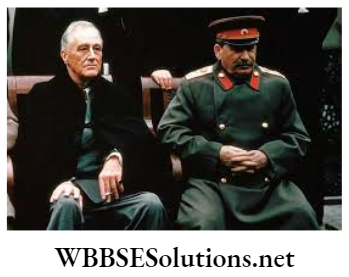
Question 12. What is Operation Barbarossa?
Answer:
Operation Barbarossa:-
On June 22, 1941 Nazi Germany and her allies began a massive invasion of the Soviet Union under Operation Barbarossa. Hitler changed the original name Operation Fritz to Operation Barbarossa to refer to Frederick Barbarossa, the Holy Roman Emperor, who had set out to conquer the Holy land in 1190.
History Class 9 WBBSE
Question 13. What is Seigfreid Line?
Answer:
Seigfreid Line:-
Seigfreid Line was a line of defensive forts and tank defences built along the German western frontier opposite the French Maginot Line in the 1930s and greatly expanded in 1941.
Question 14. Name the principal dictators of Europe who rose to power after the first World War.
Answer: The principal dictators of Europe who rose to power after the First World War were Mussolini of Italy, Hitler of Germany and general Franco of Spain.
Question 15. What were the main aims of Hitler’s foreign policy?
Answer:
The main aims of Hitler’s foreign policy were:
[1] To revise the humiliating treaty of Versailles.
[2] To unify Germany and to unite all German-speaking people into one Reich.
[3] The eastward expansion of Germany to achieve ‘Lebensraum’ (Living space).
[4] To make Germany a strong and powerful nation and to destroy communism.
Class 9 History WBBSE
Question 16. What is the significance of Italy’s attack on Abyssinia?
Answer:
The significance of Italy’s attack on Abyssinia was:
[1] It exposed the weakness of the League of Nations.
[2] The prestige of the League of Nations was damaged.
[3] Italy’s attack on Abyssinia encouraged Hitler in his aggressive policy.
[4] Italy and Germany came closer together.
Question 17. What steps were taken by the League of Nations when Italy attacked Abyssinia?
Answer: When Italy attacked Abyssinia, the League of Nations declared Italy as an aggressor country. Moreover, the League of Nations directed the member countries of the League to stop all sorts of commercial relationships with Italy.
Question 18. Why did Hitler and Mussolini come closer to each other and become allies?
Answer:
The reasons why Hitler and Mussolini came closer to each other and became allies were:
[1] Both were against the Treaty of Versailles signed in 1919.
[2] France was the enemy of both Italy and Germany.
[3] Both countries were supporters of aggressive nationalism.
Question 19. Give some examples of the Anglo-French policy of appeasement.
Answer:
Some examples of the Anglo-French policy of appeasement were:
[1] Italy’s attack on Abyssinia.
[2] Franco’s military regime was supported by Hitler and Mussolini during the Spanish Civil War.
[3] Occupation of Austria by Germany, England and France remained inactive during the aggressive policy of Italy and Germany.
Class 9 History WBBSE Chapter 6 The Second World War And Its Aftermath Topic B Impact of the Second World War and Ultranationalism vs Internationalism Short Answer (SA) Type Questions
Answer in 2 to 3 sentences
Question 1. How can you explain the Second World War as a struggle between Fascism and Nazism versus Democratic ideals?
Answer: The Second World War was in fact, the struggle of two contradictory principles, i.e, Fascism and Nazism versus democratic principles. England, France and America were the supporters of the principles of democracy, while the principles of autocracy were fully supported by Nazi Germany and Fascist Italy. Thus war was inevitable between the supporters of these two contradictory principles.
Question 2. What is UNRRA?
Answer:
UNRRA:-
As a result of the Second World War there was total destruction, devastation and despair in the whole of Europe. In order to regenerate the economy of the devastated countries United Nations Relief and Rehabilitation Administration (UNRRA) was set up in 1943 in Washington, USA.
It was an international body to provide relief to countries liberated from the German occupation. This economic recovery programme provided substantial economic help to war-ravaged countries like Poland, Italy, Yugoslavia, Czechoslovakia, Greece, Austria etc.
Question 3. What was the ‘Fulton Speech’?
Answer:
Fulton Speech:-
On 5 March 1946 the former British Prime Minister Winston Churchill delivered a speech at Westminster College, Fulton in the state of Missouri, USA. He warned that a large part of Europe from Stettin to Triest had passed under the ‘iron curtain’ of the Soviet Union. He warned that America should become alert otherwise the Soviet Union would one day conquer the entire continent of Europe.
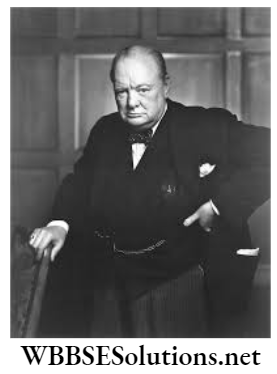
Question 4. What is Marshall Plan?
Answer:
Marshall Plan:-
The American Foreign Secretary, George Marshall, in a lecture at Harvard University spoke of a plan of the economic resurgence of war-ravaged countries like France, Britain, Belgium, Italy, West Germany etc. Marshall observed, “It is logical that the United States should do whatever it is able to do to assist in the return of normal economic health in the world, without which there can be no political stability and no assured peace.
” This plan of Marshall which wanted to save Europe from poverty, hunger and lawlessness is known as the Marshall plan, a programme to finance the recovery of the European economy.
Question 5. What is internationalism?
Answer:
Internationalism:-
Internationalism is a movement which advocates economic and political cooperation among nations for the benefit of all. It is the belief that countries can achieve more advantages by working together and trying to understand each other than by arguing and fighting wars with each other.
Question 6. What is nationalism?
Answer:
Nationalism:-
Nationalism is basically a collective state of mind or consciousness in which people believe their primary duty is loyalty to the nation-state. It implies national superiority and glorifies various national virtues. It is a political or social philosophy in which the welfare of the nation-state as an entity is considered paramount.
Question 7. What do you mean by ultranationalism?
Answer:
Ultranationalism:-
Nationalism is an ideology that emphasises devotion and loyalty to a nation or nation-state. Ultranationalism is an extreme form of nationalism. It is simply extreme devotion to one’s own nation and of the paramount importance of advancing it regardless of the effect on any other nation.
Class 9 History Book West Bengal Board WBBSE Question 8. What was decided in the Potsdam Conference?
Answer:
The decisions arrived at the Potsdam Conference were
[1] Germany will be deNazified. The Nazi Party would be banned and its leaders would be tried as war criminals.
[2] Germany will be demilitarized
[3] Germany’s large industrial factories would be dissolved.
Question 9. What are the features of ultra-nationalism?
Answer:
The features of ultranationalism are as follows:
[1] It is an extreme form of nationalism.
[2] It believes in the superiority of one’s own nation.
[3] It glorifies national identity.
[4] It includes elements of racism and fanaticism which can lead to conflict.
[5] It may involve contempt for other nations.”
[6] It supports authoritarian political arrangements.
Question 10. Name the leaders who joined the Potsdam Conference.
Answer: The leaders who joined the Potsdam Conference were Joseph Stalin of Russia, Harry S Truman of USA and Clement Attlee of Britain.
Question 11. How was Germany divided after the Second World War?
Answer: After the Potsdam Conference, Germany was divided into four occupied zone: France in the southwest, the United States is the south, Great Britain in the northwest and Soviet Union in the east. Berlin, the capital of Germany was also divided into four occupied zones.
Question 12. Mention some military equipment used during the Second World War.
Answer: Some military equipment used during the Second World War were machine guns, long-range rockets, handguns, marine, mortar, grenade launchers, submarines, modern tanks, mines etc.
Question 13. What do you understand by the term stand by the term ‘Third World’?
Answer: While the post-1945 world saw a ‘bi-polar’ world (divides into USA and Soviet spheres of influence), it also witnessed the emergence of the ‘Third World’. A group of countries in Asia, Africa and Latin (South) America which achieved independence after the Second World War and did not formally belong to either of the two rival blocs and later launched the Non-Alignment Movement in international relations is known as the Third World.

